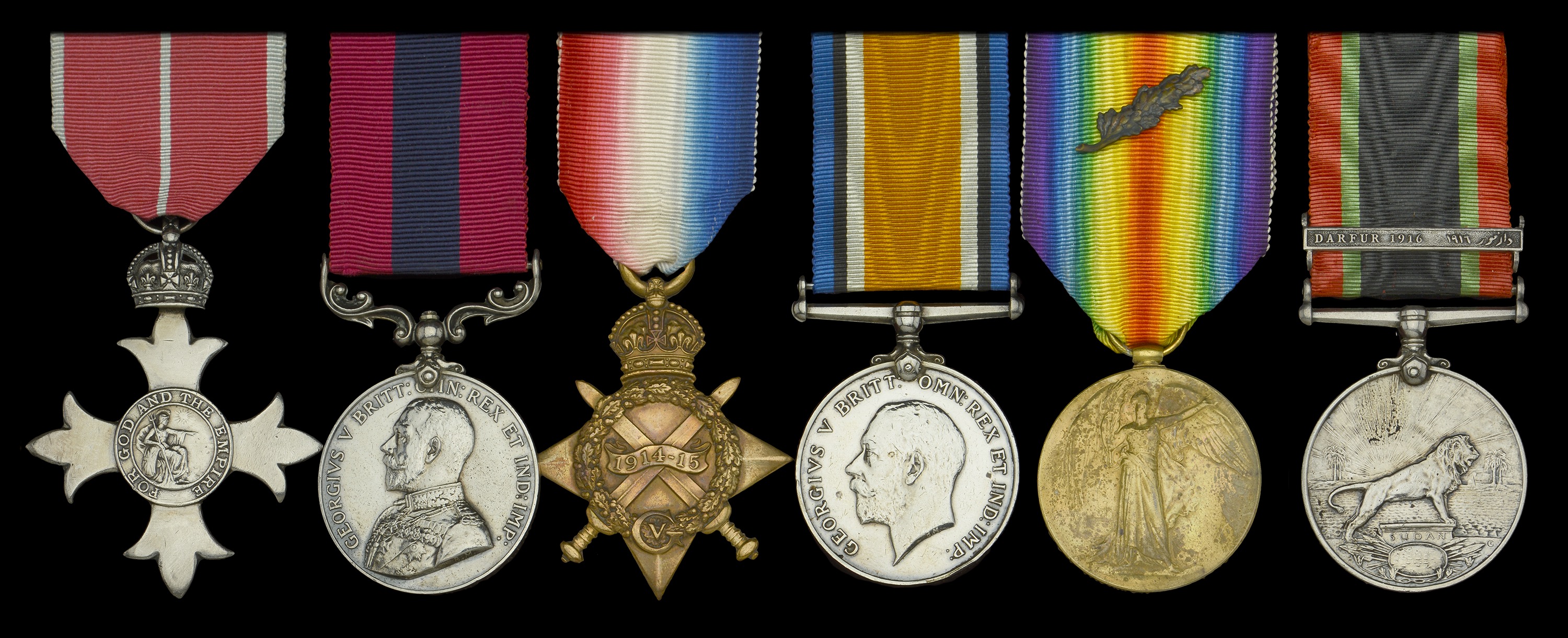The unique Great War M.B.E., ‘Darfur 1916 - Sudan operations’ D.C.M. group of six awarded to Warrant Officer Class 1 R. J. Sladden, 17 Squadron, Royal Flying Corps, who served as the senior Warrant Officer in Darfur, Sudan in 1916, and was later commissioned rising to the rank of Captain The Most Excellent Order of the British Empire, M.B.E. (Military) Member’s 1st type, breast badge, hallmarks for London ‘1919’; Distinguished Conduct Medal, G.V.R. (212 Fl. Sjt: R. J. Sladden. No. 17 Sq: R.F.C.); 1914-15 Star (212 S. Mjr. R. J. Sladden R.F.C.); British War and Victory Medals, with M.I.D. oak leaves (212 W.O. Cl. 1. R. J. Sladden R.F.C.); Khedive’s Sudan 1910-21, 1 clasp, Darfur 1916, loose on riband (212 Sjt. Mjr. R. J. Sladden. R.F.C.) officially impressed naming, with a silver shooting prize medal, hallmarks for Birmingham 1920, reverse engraved ‘F/O. Sladden Inter Squadron Officers, Halton, May 1921’, all housed in a privately made velvet lined wooden case with ‘RFC’ embossed on lid, and R.F.C. cap badge, generally very fine (6) £4,000-£5,000 --- M.B.E. London Gazette 3 June 1919: ‘In recognition of distinguished services during the war.’ D.C.M. London Gazette 31 May 1916 (Egypt): ‘For consistent good work in connection with the care and repair of aeroplanes.’ One of only 92 Distinguished Conduct Medals awarded to members of the Royal Flying Corps. Approximately 63 Khedive’s Sudan 1910 Medals were awarded to R.F.C. personnel, 23 of them with them with the ‘Darfur 1916’ clasp. Robert John Sladden was born in Stoke, Devon, and attested for the Royal Artillery at Devonport in August 1906. He served as a Gunner with 148 Battery, Royal Field Artillery prior to transferring to the Royal Flying Corps and being posted to the Flying Depot, 16 July 1912. He advanced to Sergeant in July 1913, and to Senior Mechanic 1st Class and Sergeant Major, and served with 17 Squadron in the Egyptian theatre of war, November 1915 - December 1916. Sladden participated as the senior non-commissioned officer in the Darfur operations of March-December 1916, when four B.E. 2c aircraft from the squadron’s ‘C’ Flight went into action with the Governor-General Sir Reginald Wingate’s blessing, for ‘the sudden appearance out of the blue of flying chariots would impress on Ali Dinar’s followers the futility of resistance.’ Henry Keown-Boyd’s article, From Private to Pilot (O.M.R.S., June 2010), takes up the story: ‘With hindsight, the inclusion of the Flight seems to have been a curiously unnecessary addition to the burden of the war effort bearing in mind the considerable logistical and transportation problems involved, balanced against it uncertain effectiveness. Neither the aircraft or equipment and stores required could be flown in those days the 1,000 miles to destination, so four crated aeroplanes, their fuel in drums, two Leyland lorries, four Crossley tenders, a spare aero engine, two canvas hangars together with arms, ammunition and about 60 officers and men had to be transported by sea and land, the latter part of the journey across trackless desert into central Africa. Via a series of landing grounds and depots the Flight and its equipment was transported from Port Sudan via Khartoum and El Obied by rail, lorry and camel to its main base at Nahud and advance base at Jebel el Hula.’ Keown-Boyd continues: ‘The first operational flight was made on 12 May 1916 by Lieutenant F. Bellamy and on the 17th a plane piloted by Captain Bannatyne was hit by a bullet. On the 23rd, 2nd Lieutenant (later Marshal of the Royal Air Force Sir John) Slessor was wounded in the thigh while attacking Ali Dinar’s army retreating from its defeat at the battle of Beringia but displaying a certain defiance against Wingate’s Flying Chariots! The Sultan Ali Dinar escaped from Beringia but was killed by a Camel Corps patrol a few months later.’ Having been awarded the D.C.M. for his good work in Egypt, Sladden returned to the UK at the end of 1916. He was commissioned Acting Second Lieutenant in the Royal Flying Corps in April 1917, and saw out the remainder of the war with postings in the UK. Sladden advanced to Acting Captain in March 1919, and to Flying Officer in July 1920. He subsequently served at No. 1 Technical Training School, Halton, and retired as Captain in November 1921. The medal group is illustrated in both A Contemptible Little Flying Corps by I. McInnes and J. V. Webb, and On Patrol, The Story of the Khedive’s Medal 1910-22 by B. Hewitt. M.I.D. unconfirmed.


